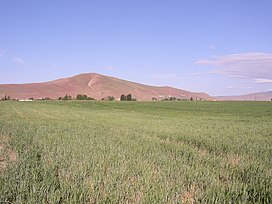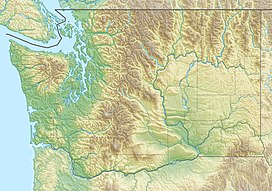
The Yakima River is a tributary of the Columbia River in south central and eastern Washington state, named for the indigenous Yakama people. Lewis and Clark mention in their journals that the Chin-nâm pam called the river Tâpe têtt, possibly from the French tape-tête, meaning "head hit". The length of the river from headwaters to mouth is 214 miles (344 km), with an average drop of 9.85 feet per mile (1.866 m/km). It is the longest river entirely in Washington state.

The Tri-Cities are three closely linked cities at the confluence of the Yakima, Snake, and Columbia Rivers in the Columbia Basin of Eastern Washington. The cities border one another, making the Tri-Cities seem like one uninterrupted mid-sized city. The three cities function as the center of the Tri-Cities metropolitan area, which consists of Benton and Franklin counties. The Tri-Cities urban area consists of the city of West Richland, the census-designated places (CDP) of West Pasco and Finley, as well as the CDP of Burbank, despite the latter being located in Walla Walla County.
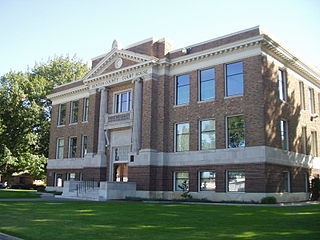
Benton County is a county in the south-central portion of the U.S. state of Washington. As of the 2020 census, its population was 206,873. The county seat is Prosser, and its largest city is Kennewick. The Columbia River demarcates the county's north, south, and east boundaries.

Yakima County is a county in the U.S. state of Washington. As of the 2020 census, its population was 256,728. The county seat and largest city is Yakima. The county was formed out of Ferguson County in January 1865 and is named for the Yakama tribe of Native Americans.

West Richland is a city in Benton County, Washington. The population was 16,295 at the time of the 2020 census. The city is part of the Tri-Cities metropolitan area, whose principal cities are Richland, Kennewick, and Pasco.

Cabernet Franc is one of the major black grape varieties worldwide. It is principally grown for blending with Cabernet Sauvignon and Merlot in the Bordeaux style, but can also be vinified alone, as in the Loire's Chinon. In addition to being used in blends and produced as a varietal in Canada and the United States, it is sometimes made into ice wine in those regions.

Malbec is a purple grape variety used in making red wine. The grapes tend to have an inky dark color and robust tannins, and are known as one of the six grapes allowed in the blend of red Bordeaux wine. In France, plantations of Malbec are now found primarily in Cahors in South West France, though the grape is grown worldwide. It is increasingly celebrated as an Argentine varietal.

Blaufränkisch is a dark-skinned variety of grape used for red wine. Blaufränkisch, which is a late-ripening variety, produces red wines which are typically rich in tannin and may exhibit a pronounced spicy character.

Washington wine is a wine produced from grape varieties grown in the U.S. state of Washington. Washington ranks second in the United States in the production of wine. By 2017, the state had over 55,000 acres (220 km2) of vineyards, a harvest of 229,000 short tons (208,000 t) of grapes, and exports going to over 40 countries around the world from the 940+ wineries located in the state. While there are some viticultural activities in the cooler, wetter western half of the state, the majority (99.9%) of wine grape production takes place in the shrub-steppe eastern half. The rain shadow of the Cascade Range leaves the Columbia River Basin with around 8 inches (200 mm) of annual rain fall, making irrigation and water rights of paramount interest to the Washington wine industry. Viticulture in the state is also influenced by long sunlight hours and consistent temperatures.

The Columbia Valley AVA is an American Viticultural Area which lies in the Columbia River Plateau, through much of central and southern Washington State, with a small section crossing into the neighboring state of Oregon. The AVA includes the drainage basin of the Columbia River and its tributaries through much of Washington. Allen Shoup, president of Washington State's largest winery Chateau Ste. Michelle, understood the importance of obtaining appellation status for Washington State to grow the reputation of the vineyards. He hired Drs. Wade Wolfe and Walter Clore to petition the federal government for appellation status, a request that was granted in 1984. The Columbia Valley AVA is the largest wine region in the state of Washington, including over 11,000,000 acres (4,500,000 ha), of which over 50,000 acres (20,000 ha) are planted in vineyards. The Columbia Valley AVA includes 99% of the total vineyard area planted in the state of Washington. Grapes grown here include Cabernet Sauvignon, Merlot, Chardonnay, Riesling, Syrah, Pinot Gris, and Sauvignon blanc. Concord grapes and other Vitis labrusca grapes are grown in the region as well. The unique climates of the area allow the Columbia Valley to produce wines that are very fruit-forward, like California wine, but which also retain some of the balance and structure of European wine.
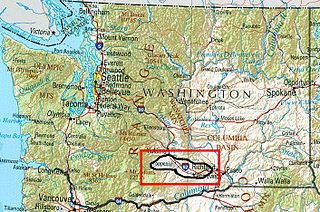
The Yakima Valley AVA was the first American Viticultural Area established within Washington state, gaining the recognition in 1983. Part of the larger Columbia Valley AVA, Yakima Valley AVA is home to more than 18,000 acres (73 km2) of vineyards, giving the area the largest concentration of wineries and vineyards in the state. The most widely planted varietals in the area are Chardonnay, Riesling, Merlot, Cabernet Sauvignon, Pinot gris, and Syrah. Nearly 40% of Washington state yearly wine production is made from Yakima Valley grapes. In addition to grapes, the Yakima Valley is also home to several fruit orchards growing apples, cherries, nectarines, peaches, pears and plums. Around the town of Zillah, there is the Zillah Fruit Loop driving tour through the area's orchards and vineyards. The area is also home to nearly 80% of the US hop production.

The Red Mountain AVA is an American Viticultural Area that includes the land surrounding Red Mountain in Benton County, Washington. It is part of the Yakima Valley AVA, which in turn is part of the larger Columbia Valley AVA. Located between Benton City and the City of West Richland, the Red Mountain AVA is the smallest in the state at only 4,040 acres (1,630 ha) in area. The area has more than 2,000 acres (810 ha) under cultivation of primarily red varietals including Cabernet Sauvignon, Merlot, Sangiovese, Cabernet Franc and Syrah. The reputation of the wines produced in this area has brought Red Mountain AVA worldwide acclaim. The vineyards in this appellation have produced grapes for some of the most sought after wines in Washington State.

The Walla Walla Valley AVA is an American Viticultural Area located within Washington state and extending partly into the northeastern corner of Oregon. The wine region is entirely included within the larger Columbia Valley AVA. In addition to grapes, the area produces sweet onions, wheat and strawberries. After the Yakima Valley AVA, the Walla Walla AVA has the second highest concentration of vineyards and wineries in Washington State. Walla Walla hosts about 140 wineries.

Established in 2006 The Wahluke Slope AVA Wahluke, was named after a Native American word for "watering place," is an American Viticultural area located within Grant County, Washington and is home to more than 20 vineyards and at least three wine production facilities. It is part of the larger Columbia Valley AVA. The 80,490 acre region features approximately 8,931 acres of vineyards: nearly 15 percent of the total wine grape acreage in the state. Top grape varieties: Merlot, Syrah, Cabernet Sauvignon, Riesling, Chardonnay, and Chenin Blanc, but this area is primarily known for Merlot and Cabernet Sauvignon.

Texas has a long history of wine production. The sunny and dry climate of the major winemaking regions in the state have drawn comparison to Portuguese wines, in addition to other regions in Europe like Spain, France, and Italy. Some of the earliest recorded Texas wines were produced by Spanish missionaries in the 1650s near El Paso. Texas ranked as the fifth largest wine producing state by 2019.
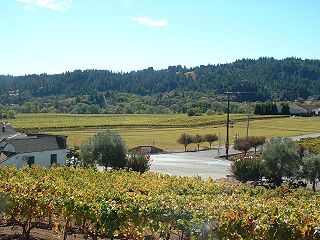
Sonoma County wine is wine made in Sonoma County, California, in the United States.

State Route 224 (SR 224) is a 10.15-mile (16.33 km) long state highway located entirely in Benton County, Washington, United States. The highway serves to connect SR 225 to Interstate 82 (I-82) and U.S. Route 12 (US 12), and to link Benton City to West Richland and Richland. Before the 1964 state highway renumbering the highway was numbered Secondary State Highway 3R. SR 224 is a lightly traveled rural highway except through Richland, where an average of 16,000 cars traveled the highway daily in 2009. The Washington State Department of Transportation (WSDOT) rebuilt its southern terminus as a roundabout in 2016, as part of a project to improve traffic congestion near the Red Mountain AVA.
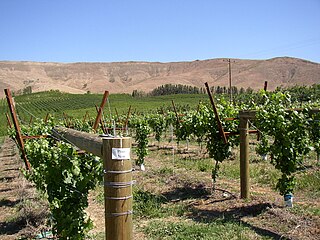
The Rattlesnake Hills, also known as Rattlesnake Ridge, is a 16-mile (26 km) long anticline mountain ridge in Yakima County and Benton County in the U.S. state of Washington. It should not be confused with the much smaller Rattlesnake Ridge located near the west end of Ahtanum Ridge just south of Yakima, Washington and west of Union Gap, Washington. The highest point in the hills is the 3,629 feet (1,106 m) Lookout Summit, which surpasses the more well-known Rattlesnake Mountain by approximately 100 ft (30 m). The Rattlesnake Hills are part of the Yakima Fold Belt of east-tending long ridges formed by the folding of Miocene Columbia River basalt flows.

Champoux Vineyard is a grape growing estate located in the Horse Heaven Hills AVA of Washington state. Grapes grown in the vineyard have been used to produce some of the most critically acclaimed Washington wines with the name Champoux regularly being featured on vineyard designated wines. Paul Gregutt, wine writer for the Seattle Times and Wine Enthusiast, list Champoux as one of the "top ten" vineyards in the entire state. Cabernet Sauvignon grapes from Champoux vineyards were featured in the consecutive 100 point Robert Parker rated wines from Quilceda Creek Vintners for the 2002 and 2003 vintages.

Red Willow Vineyard is a grape-growing estate located in the far western end of Yakima Valley AVA, within the Yakama Indian Reservation. Beginning with their relationship with Columbia Winery and Master of Wine David Lake, grapes from Red Willow have been used to produce some of the most critically acclaimed Washington wines with the vineyard's name regularly being featured on vineyard designated wines. Paul Gregutt, wine writer for the Seattle Times and Wine Enthusiast, list Red Willow as one of the "top ten" vineyards in the entire state.
